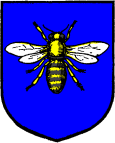HOME
Introduction
Index
1
2
3
4
5
6
7
8
9
10
11
12
13
14
15
16
17
18
19
20
21
22
23
24
25
26
27
28
29
30
31
32
33
34
35
36
37
38
39
40
41
42
XVII
CHAPTER XVII
INSECTS
 |
| FIG. 485.--Bee volant. |
THE insect which is most usually met with in heraldry is undoubtedly the Bee. Being considered, as it is, the symbol of industry, small wonder that it has been so frequently adopted. It is usually represented as if displayed upon the shield, and it is then termed volant, though of course the real term which will sometimes be found used is "volant en arrière" (Fig. 485). It occurs in the arms of Dore, Beatson, Abercromby, Samuel, and Sewell, either as a charge or as a crest. Its use, however, as a crest is slightly more varied, inasmuch as it is found walking in profile, and with its wings elevated, and also perched upon a thistle as in the arms
of Ferguson. A bee-hive "with bees diversely volant" occurs in the arms of Rowe, and the popularity of the bee in British armory is doubtless due to the frequent desire to perpetuate the fact that the foundation of a house has been laid by business industry. The fact that the bee was adopted as a badge by the Emperor Napoleon gave it considerable importance in French armory, inasmuch as he assumed it for his own badge, and the mantle and pavilion around the armorial bearings of the Empire were semé of these insects. They also appeared upon his own coronation mantle. He adopted them under the impression, which may or may not be correct, that they had at one time been the badge of Childeric, father of Clovis. The whole story
connected with their assumption by Napoleon has been a matter of much controversy, and little purpose would be served by going into the matter here, but it may be added that Napoleon changed the fleur-de-lis upon the chief in the arms of Paris to golden bees upon a chief of gules, and a chief azure, semé of bees or, was added as indicative of their rank to the arms of "Princes-Grand-Dignitaries of the Empire." A bee-hive occurs as the crest of a family named Gwatkin, and also upon the arms of the family of Kettle of Wolverhampton.
The Grasshopper is most familiar as the crest of the family of Gresham, and this is the origin of the golden grasshoppers which are so constantly met with in the city of London. "Argent, a chevron sable between three grasshoppers vert" is the coat of arms of Woodward of Kent. Two of them figure in the arms of Treacher, which arms are now quartered by Bowles.
Ants are but seldom met with. "Argent, six ants, three, two, and one sable," is a coat given by Papworth to a family of the name of Tregent; "Vert, an ant argent," to Kendiffe; and "Argent, a chevron vert between three beetles proper" are the arms attributed by the same authority to a family named Muschamp. There can be little doubt, however, that these "beetles" should be described as flies.
Butterflies figure in the arms of Papillon ["Azure, a chevron between three butterflies volant argent "] and in the arms of Penhellicke["Sable, three butterflies volant argent "].
Gadflies are to be found in a coat of arms for the name of Adams["Per pale argent and gules, a chevron between three gadflies counterchanged"], and also in the arms of Somerscales, quartered by Skeet of Bishop Stortford. "Sable, a hornet argent" is one blazon for the arms of Bollord or Bolloure, but elsewhere the same coat is blazoned: "Sable, a harvest-fly in pale volant en arrière argent." Harvest flies were the charges on the arms of the late Sir Edward Watkin, Bart.
Crickets appear in the arms ["azure, a fire chest argent, flames proper, between three crickets or "] recently granted to Sir George Anderson Critchett, Bart.
The arms of Bassano (really of foreign origin and not an English coat) are: "Per chevron vert and argent, in chief three silkworm flies palewise en arrière, and in base a mulberry branch all counterchanged." "Per pale gules and azure, three stag-beetles, wings extended or," is assigned by Papworth to the Cornish family of Dore, but elsewhere these charges (under the same family name) are quoted as bees, gadflies, and flies. "Or, three spiders azure" is quoted as a coat for Chettle. A spider also figures as a charge on the arms of Macara. The crest of Thorndyke of Great Carleton, Lincolnshire, is: "On a wreath of the colours a damask rose proper, leaves and thorns vert, at the bottom of the shield a beetle or scarabæus proper."
Woodward, in concluding his chapter upon insects, quotes the arms of the family of Pullici of Verona, viz.: "Or, semé of fleas sable, two bends gules, surmounted by two bends sinister of the same."
XVII
1
2
3
4
5
6
7
8
9
10
11
12
13
14
15
16
17
18
19
20
21
22
23
24
25
26
27
28
29
30
31
32
33
34
35
36
37
38
39
40
41
42
Introduction
Index
HOME
Build: 2012/06/26 06:24:19.53+0900(JST)

